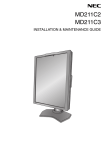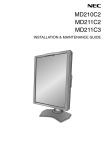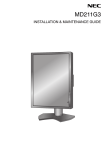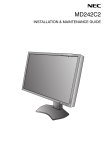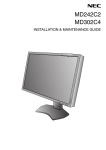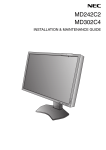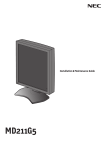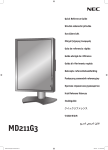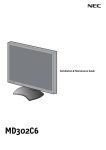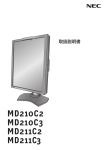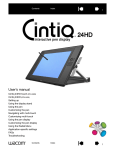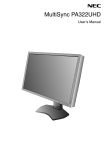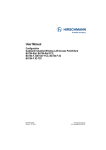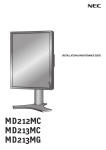Download NEC MultiSync MD210C2
Transcript
MD210C2 MD211C2 MD211C3 INSTALLATION & MAINTENANCE GUIDE Index Warning, Caution ..........................................................................................................................English-1 Intended Use ................................................................................................................................English-2 Registration Information ...............................................................................................................English-3 Recommended use ......................................................................................................................English-4 Contents .......................................................................................................................................English-6 Quick Start....................................................................................................................................English-7 Controls ........................................................................................................................................English-12 Using the PICTURE MODE function ............................................................................................English-16 Quick screen QA test function ......................................................................................................English-17 Advanced OSD.............................................................................................................................English-18 Specifications - MD210C2 ............................................................................................................English-23 Specifications - MD211C2 ............................................................................................................English-24 Specifications - MD211C3 ............................................................................................................English-25 Features .......................................................................................................................................English-26 Troubleshooting ............................................................................................................................English-27 STAND-ALONE CALIBRATION ...................................................................................................English-28 Self Calibration .............................................................................................................................English-29 Copy Calibration ...........................................................................................................................English-30 Gamma Adjust ..............................................................................................................................English-31 DICOM Measurement ..................................................................................................................English-32 AMBIENT SENSOR CALIBRATION.............................................................................................English-32 Manufacturer’s Recycling and Energy Information.......................................................................English-34 Symbol Information This symbol warns user that uninsulated voltage within the unit may have sufficient magnitude to cause electric shock. Therefore, it is dangerous to make any kind of contact with any part inside this unit. This symbol alerts the user that important literature concerning the operation and maintenance of this unit has been included. Therefore, it should be read carefully in order to avoid any problems. Protective earth terminal marked. Main switch ON. Main switch OFF. AC Input. UL MARK CERTIFICATION, ANSI/AAMI ES60601-1:2005 cUL, CAN/CSA-C22.2 NO.60601-1:08 MEDICAL - GENERAL MEDICAL EQUIPMENT AS TO ELECTRICAL SHOCK, FIRE AND MECHANICAL HAZARD ONLY IN ACCORDANCE WITH ANSI/AAMI ES60601-1:2005 AND CAN/CSA-C22.2 NO.60601-1:08 ALSO LISTED ACCORDANCE WITH UL 60950-1 AND CAN/CSA-C22.2 NO.60950-1-07 45VU E332883 Windows is a registered trademark of Microsoft Corporation. NEC is a registered trademark of NEC Corporation. ErgoDesign is a registered trademark of NEC Display Solutions, Ltd. in Austria, Benelux, Denmark, France, Germany, Italy, Norway, Spain, Sweden, U.K. All other brands and product names are trademarks or registered trademarks of their respective owners. DisplayPort and DisplayPort Compliance Logo are trademarks owned by the Video Electronics Standards Association. TO PREVENT FIRE OR SHOCK HAZARDS, DO NOT EXPOSE THIS UNIT TO RAIN OR MOISTURE. ALSO, DO NOT USE THIS UNIT’S POLARIZED PLUG WITH AN EXTENSION CORD RECEPTACLE OR OTHER OUTLETS UNLESS THE PRONGS CAN BE FULLY INSERTED. REFRAIN FROM OPENING THE CABINET AS THERE ARE HIGH VOLTAGE COMPONENTS INSIDE. REFER SERVICING TO QUALIFIED SERVICE PERSONNEL. CAUTION TO REDUCE THE RISK OF ELECTRIC SHOCK, MAKE SURE POWER CORD IS UNPLUGGED FROM WALL SOCKET. TO FULLY DISENGAGE THE POWER TO THE UNIT, PLEASE DISCONNECT THE POWER CORD FROM THE AC OUTLET. DO NOT REMOVE COVER (OR BACK). NO USER SERVICEABLE PARTS INSIDE. REFER SERVICING TO QUALIFIED SERVICE PERSONNEL. Power Cord Important Information CAUTION: Please use the power cord provided with this monitor in accordance with the table below. If a power cord is not supplied with this equipment, please contact your supplier. For all other cases, please use a power cord that matches the AC voltage of the power outlet and has been approved by and complies with the safety standard of your particular country. When you use this Monitor in North America, you should use a North America Hospital Grade power cord. Plug Type Plug Shape North America European Continental U.K. Chinese Japanese (green dot and tag label) Country U.S.A./Canada EU (except U.K.) U.K. China Japan Voltage 120 230 230 220 100 NOTE: This product can only be serviced in the country where it was purchased. English-1 English WARNING Intended Use The MD210C2/MD211C2/MD211C3 Color displays are intended to be used for displaying and viewing of digital images for diagnosis by trained physicians. To guarantee the display performance as specified, it must only be used in conjunction with NEC approved display controllers. MD210C2/MD211C2/MD211C3 cannot be used for a life-support system. This device must not be used in digital mammography. This device is designed for exclusive interconnection with IEC 60601-1-1 certified equipment. Contraindications: None known. Safety Precaution The unit is designed for exclusive interconnection with IEC 60950 certified equipment outside of patient environment and IEC 60601-1 certified equipment inside the patient environment. • Equipment connected to digital interfaces must comply with the respective IEC standards (e.g. IEC 60950 for data processing equipment and IEC 60601-1 for medical equipment). • This device complies with IEC 60601-1-2. To minimize the interference from other equipment, a minimum 0.5 m distance shall be kept form other potential electromagnetic sources, such as a cell phone. • To reduce the risk of electric shock, make sure the power cord is unplugged from the wall socket. To fully disengage the power to the unit, please disconnect the power cord from the ac outlet. Do not remove the front or back cover. No user serviceable parts inside. Refer servicing to qualified service personnel. The AC outlet shall be readily available and accessible. This device uses temperature-controlled fans for internal cooling. The use of this device in surgery rooms is not recommended if cleaning of the air intakes from dust and textile lint in regular time intervals cannot be performed by the user (maximum interval: six months). This device is equipped with an integrated front sensor and ambient light sensor complying with the IEC 62563-1 standard requirements for measurement devices with a calibration traceable to a primary standards laboratory. Therefore, these sensors can be re-calibrated using external luminance and illuminance meters as a reference, which were calibrated following country specific legal obligations for metrological control. When re-calibrated in a regular manner, the integrated front sensor and ambient light sensor may then be used for remote quality assurance following the IEC 62563-1 standard. NEC Display Solutions recommends to check the integrated front sensor and ambient light sensor intervals of two (2) years. North America Customers Grounding reliability can only be achieved when the equipment is connected to an equivalent receptacle marked “Hospital Only” or “Hospital Grade”. That signal input port need to be connected properly and that any unused signal input port shall not be accessible for the patient to contact in the patient area after the LCD is integrated into a medical system. Federal law restricts this device to sale by or on the order of a licensed healthcare practitioner. European Customers Unpacking, installation and calibration of this monitor must only be done by authorized and trained personnel. Any installation done by a non-authorized person is done under his own risk and we accept no responsibility in any device malfunctioning. Medical Imaging MD210C2/MD211C2 is designed for 1200 x 1600 (portrait mode) or 1600 x 1200 (landscape mode) medical imaging. MD211C3 is designed for 1536 x 2048 (portrait mode) or 2048 x 1536 (landscape mode) medical imaging. English-2 English Registration Information Declaration Declaration of the Manufacturer NEC Display Solutions Europe GmbH declares that the product listed is in conformity with the essential requirements and provisions of the Council Directive 93/42/EEC, including the amendments of the Council Directive 2007/47/EC, and conforms to the applicable clauses of the following standards: Means of Conformity Device Classification: Class I, non-measuring function Applicable Rules: Annex IX, Rules 1.4 (Section 1) and 1.1 (Section 3) Product Name: MD211C2/MD210C2/MD211C3 21.3" Diagnostic Imaging Color LCD Monitor Model Number: MD211C2/(MD210C2)/MD211C3 UMDNS Code: 16-603 – EN 60601-1 – EN 60601-1-2 – EN 61000-3-2 – EN 61000-3-3 NEC Display Solutions Europe GmbH Landshuter Allee 12-14. 80637 Muenchen, Germany Canadian Department of Communications Compliance Statement DOC: This Class B digital apparatus meets all requirements of the Canadian Interference-Causing Equipment Regulations. C-UL: Bears the C-UL Mark and is in compliance with Canadian Safety Regulations according to CAN/CSA C22.2 No. 601-1:08. FCC Information 1. Use the attached specified cables with the MD211C2/MD210C2/MD211C3 color monitor so as not to interfere with radio and television reception. (1) Please use the supplied power cord or equivalent to ensure FCC compliance. (2) Please use the supplied shielded DVI-D or DisplayPort video signal cable. Use of other cables and adapters may cause interference with radio and television reception. 2. This equipment has been tested and found to comply with the limits for a Class B digital device, pursuant to part 15 of the FCC Rules. These limits are designed to provide reasonable protection against harmful interference in a residential installation. This equipment generates, uses, and can radiate radio frequency energy, and, if not installed and used in accordance with the instructions, may cause harmful interference to radio communications. However, there is no guarantee that interference will not occur in a particular installation. If this equipment does cause harmful interference to radio or television reception, which can be determined by turning the equipment off and on, the user is encouraged to try to correct the interference by one or more of the following measures: • • • • Reorient or relocate the receiving antenna. Increase the separation between the equipment and receiver. Connect the equipment into an outlet on a circuit different from that to which the receiver is connected. Consult your dealer or an experienced radio/TV technician for help. If necessary, the user should contact the dealer or an experienced radio/television technician for additional suggestions. The user may find the following booklet, prepared by the Federal Communications Commission, helpful: “How to Identify and Resolve Radio-TV Interference Problems.” This booklet is available from the U.S. Government Printing Office, Washington, D.C., 20402, Stock No. 004-000-00345-4. Declaration of Conformity This device complies with Part 15 of FCC Rules. Operation is subject to the following two conditions. (1) This device may not cause harmful interference, and (2) this device must accept any interference received, including interference that may cause undesired operation. U.S. Responsible Party: NEC Display Solutions of America, Inc. Address: 500 Park Boulevard, Suite 1100 Itasca, Illinois 60143 Tel. No.: (630) 467-3000 Type of Product: Display Monitor Equipment Classification: Class B Peripheral Model: MD211C2/MD210C2/MD211C3 We hereby declare that the equipment specified above conforms to the technical standards as specified in the FCC Rules. Classification According to the type of protection against electric shock: CLASS I According to the degree of protection against electric shock: No applied part According to the degree of protection against ingress of water as detailed in the current edition of IEC529: IPX0 According to the method of sterilization or disinfection recommended by the manufacturer: Not Specified According to the degree of safety of application in the presence of a FLAMMABLE AN AESTHETIC MIXTURE WITH AIR or a WITH OXYGEN OR NITROUS OXIDE: Not AP or APG category According to the mode of operation: Continuous operation English-3 Recommended use Safety Precautions and Maintenance FOR OPTIMUM PERFORMANCE, PLEASE NOTE THE FOLLOWING WHEN SETTING UP AND USING THE LCD MONITOR: WARNING: Do not modify this equipment without authorization of the manufacturer. WARNING: To disconnect this product from the mains supply disconnect the mains plug from the socket outlet. WARNING: To avoid risk of electric shock, this equipment must only be connected to a supply mains with protective earth. WARNING: No modification of this equipment is allowed. WARNING: For EMC details information, please contact NEC local authority. • DO NOT OPEN THE MONITOR. There are no user serviceable parts inside and opening or removing covers may expose you to dangerous shock hazards or other risks. Refer all servicing to qualified service personnel. • Do not spill any liquids into the cabinet or use your monitor near water. • Do not insert objects of any kind into the cabinet slots, as they may touch dangerous voltage points, which can be harmful or fatal or may cause electric shock, fire or equipment failure. • Do not place any heavy objects on the power cord. Damage to the cord may cause shock or fire. • Do not place this product on a sloping or unstable cart, stand or table, as the monitor may fall, causing serious damage to the monitor. • The power supply cord you use must have been approved by and comply with the safety standards of your country. (Type H05VV-F 3G 1mm2 should be used in Europe). • In UK, use a BS-approved power cord with molded plug having a black (5A) fuse installed for use with this monitor. • Do not place any objects onto the monitor and do not use the monitor outdoors. • Do not bend power cord. • Do not use monitor in high temperatured, humid, dusty, or oily areas. • Temperature controlled fans are implemented in this monitor. For reliable performance and long useful life of this product, it is mandatory to not cover any vents on the monitor. • Vibration can damage the backlight. Do not install where the monitor will be exposed to continual vibration. • If monitor or glass is broken, do not come in contact with the liquid crystal and handle with care. • To prevent damage to the LCD monitor caused by tipping over due to earthquakes or other shocks, make sure to install the monitor in a stable location and take measures to prevent falling. • Please do not touch patient and this medical device at the same time. Immediately turn off the power, unplug your monitor from the wall outlet and move to a safe location then refer servicing to qualified service personnel under the following conditions. If the monitor is used in this condition, the monitor may cause fall, fire and electric shock: • If the monitor stand has been cracked or peeled. • If the monitor has been wobbled. • If the monitor has an unusual odor. • When the power supply cord or plug is damaged. • If liquid has been spilled, or objects have fallen into the monitor. • If the monitor has been exposed to rain or water. • If the monitor has been dropped or the cabinet damaged. • If the monitor does not operate normally by following operating instructions. CAUTION • Allow adequate ventilation around the monitor so that heat can properly dissipate. Do not block ventilated openings or place the monitor near a radiator or other heat sources. Do not put anything on top of monitor. • The power cable connector is the primary means of detaching the system from the power supply. The monitor should be installed close to a power outlet which is easily accessible. • Handle with care when transporting. Save packaging for transporting. • Do not touch LCD panel surface while transporting, mounting and setting. Applying pressure on the LCD panel can cause permanent damage. • Carry the monitor holding the built-in handle and bottom frames of the monitor. • Do not carry holding only the stand. • This monitor has the integrated front sensor. Do not touch the integrated front sensor while carrying the monitor. Do not apply any stress to the integrated front sensor. • This device uses temperature-controlled fans for internal cooling. The use of this device in surgery rooms is not recommended if cleaning of the air intakes from dust and textile lint in regular time intervals cannot be performed by the user (interval: max. six months). English-4 b) This model is equipped with an integrated front sensor and ambient light sensor complying with the IEC 62563-1 standard requirements for measurement devices with a calibration traceable to a primary standards laboratory. Therefore, these sensors can be re-calibrated using external luminance and illuminance meters as a reference, which were calibrated following country specific legal obligations for metrological control. When re-calibrated in a regular manner, the integrated front sensor and ambient light sensor may then be used for remote quality assurance following the IEC 62563-1 standard. NEC Display Solutions recommends to re-calibrate the integrated front sensor and ambient light sensor latest after 2 years, whichever comes first. CORRECT PLACEMENT AND ADJUSTMENT OF THE MONITOR CAN REDUCE EYE, SHOULDER AND NECK FATIGUE. CHECK THE FOLLOWING WHEN YOU POSITION THE MONITOR: • For optimum performance, allow 30 minutes for the monitor to warm up. • Adjust the monitor height so that the top of the screen is at or slightly below eye level. Your eyes should look slightly downward when viewing the middle of the screen. • Position your monitor no closer than 40 cm (15.75 inches) and no further away than 70 cm (27.56 inches) from your eyes. The optimal distance is 50 cm (19.69 inches). • Rest your eyes periodically by focusing on an object at least 20 feet away. Blink often. • Position the monitor at a 90° angle to windows and other light sources to minimize glare and reflections. Adjust the monitor tilt so that ceiling lights do not reflect on your screen. • Avoid displaying fixed patterns on the monitor for long periods of time to avoid image persistence (after-image effects). • Get regular eye checkups. NOTE: This model is set up in the factory so that the NEC logo is briefly displayed after the monitor is powered on. This feature can be turned on or off in the Advanced OSD. In case you find such bright Brand Logo annoying in your reading room environment, you may easily switch this off. By keeping the “EXIT” button pressed while this logo is displayed, the BOOT LOGO menu will appear. It is possible to change the BOOT LOGO setting to OFF. Cleaning the LCD Panel • When the LCD is dusty, please gently wipe with a soft cloth. • Please do not rub the LCD panel with hard or coarse material. • Please do not apply pressure to the LCD surface. • Please do not use OA cleaner as it will cause deterioration or discoloration on the LCD surface. Cleaning the Cabinet • Unplug the power supply • Gently wipe the cabinet with a soft cloth • To clean the cabinet, dampen the cloth with a neutral detergent and water, wipe the cabinet and follow with a dry cloth. NOTE: Many plastics are used on the surface of the cabinet. DO NOT clean with benzene, thinner, alkaline detergent, alcoholic system detergent, glass cleaner, wax, polish cleaner, soap powder, or insecticide. Do not touch rubber or vinyl to the cabinet for a long time. These types of fluids and fabrics can cause the paint to deteriorate, crack or peel. English-5 English Image Persistence: When a residual or “ghost” image of a previous image remains visible on the screen, this is called image persistence. Unlike CRT monitors, LCD monitors’ image persistence is not permanent, but constant images being displayed for a long period of time should be avoided. To alleviate image persistence, turn off the monitor for as long as the previous image was displayed. For example, if an image was on the monitor for one hour and a residual image remains, the monitor should be turned off for one hour to erase the image. NOTE: As with all personal display devices, NEC DISPLAY SOLUTIONS recommends using a moving screen saver at regular intervals whenever the screen is idle or turning off the monitor when not in use. Maintenance: a) Before first use of this monitor for diagnostic imaging, an initial calibration to DICOM Part 14 is highly recommended. To ensure constant visual quality over the life of this monitor, the recommended time interval to re-calibrate this model is 12 months. Contents Your new NEC monitor box* should contain the following: • MD210C2/MD211C2/MD211C3 monitor with tilt/swivel/pivot/height adjust stand • Power Cord • DVI-D cable*1 • DisplayPort cable • USB Cable • Quick Reference Guide • CD-ROM x 2 • Screw (x 4) (to mount the monitor to a flexible arm (page 11)) Screws Power Cord*2 CD-ROM x 2 Quick R eferenc e Guide Quick Reference Guide DVI-D cable*1 USB Cable DisplayPort cable * Remember to save your original box and packing material to transport or ship the monitor. *1 Dual link DVI-D cable for MD211C3 only. *2 Type and number of power cords included will depend on the where the LCD monitor is to be shipped. When more than one power cord is included, please use a power cord that matches the AC voltage of the power outlet and has been approved by and complies with the safety standard of your particular country. English-6 To connect the LCD monitor to your system, follow these instructions: NOTE: Make sure to read “Recommended Use” (page 4) before installation. In order to display the maximum resolution, a display controller that can output a resolution of 1200 x 1600 (in portrait mode) or 1600 x 1200 (in landscape mode) for MD210C2/MD211C2 and 1536 x 2048 (in portrait mode) or 2048 x 1536 (in landscape mode) for MD211C3 is needed. 1. Turn off your computer. 2. For a PC with DVI digital output: Connect the DVI-D cable to the connector of the display controller in your system (Figure A.1). Tighten all screws. For a PC with DisplayPort output: Connect the DisplayPort cable to the connector of the display controller in your system (Figure A.2). DVI-D cable DisplayPort cable Figure A.1 NOTE: Figure A.2 1. Please use a DisplayPort cable with a DisplayPort logo. 2. When removing the DisplayPort cable, hold down the top button to release the lock. 3. Height adjustment is locked by a lock button. Place hand on top of the monitor stand to push down the screen to the lowest position. Slide the lock button to unlock (Figure B.1). NOTE: Handle with care when unlocking the stand. Place hands on each side of the monitor to tilt the LCD panel to a 30-degree tilt angle and lift up to the highest position. Slide the cable cover up (Figure B.2). NOTE: The cable cover is not removable. 30° Tilt Cable cover Figure B.1 Figure B.2 English-7 English Quick Start 4. Connect all cables to the appropriate connectors (Figure C.1). When using the USB cable, connect the B type connector to the USB upstream port on the right back side of the monitor and the A type connector to the downstream port on the computer (Figure C.1a). If using the cord from a USB device, plug into one of the downstream ports of the monitor. NOTE: Incorrect cable connections may result in irregular operation, damage display quality/components of the LCD module and/or shorten the module’s life. NOTE: Up to 5 sub monitors can be daisy-chained. 30° Tilt A Type Power cord Highest Stand Position A Type B Type B Type DVI-D Cable DisplayPort Cable USB Upstream Port Figure C.1a USB Downstream Port Sensor Port*1 Figure C.1 5. To keep the cables neatly organized, place them into the cable management system that is built into the stand. Place the cables in the hooks firmly and evenly (Figure C.2 and Figure C.3). 6. Please check that you can still rotate, raise and lower the monitor screen when you have installed the cables. Power Cord DVI-D Cable Power Cord DVI-D Cable DisplayPort Cable USB Cable USB Cable DisplayPort Cable Figure C.2 Figure C.3 *1 Connect the optional USB color sensor to this port for self calibration. (See page 29) Please only use an USB color sensor according to our specifications. English-8 8. Connect one end of the power cord to the AC inlet on the back of the monitor and the other end to the power outlet. NOTE: Please refer to the Caution section of this manual for proper selection of an AC power cord. Figure D.1 9. Turn on the monitor with power switch on the top (Portrait) or left side (Landscape) of the monitor (Figure E.1). Turn on the computer. NOTE: If you have any problems, please refer to the Troubleshooting section of this Manual. Power switch Figure E.1 Raise and Lower Monitor Screen The monitor may be raised or lowered in either Portrait or Landscape mode. To raise or lower the screen, place hands on each side of the monitor and lift or lower to the desired height (Figure RL.1). NOTE: Handle with care when raising or lowering the monitor screen. Figure RL.1 English-9 English 7. Slide down the cable cover (Figure D.1). Screen Rotation Before rotating, the screen must be raised to the highest level and tilt to avoid knocking the screen on the desk or pinching your fingers. Disconnect all cables. To raise the screen, place hands on each side of the monitor and lift up to the highest position (Figure RL.1). To rotate the screen, place hands on each side of the monitor and turn clockwise from Landscape to Portrait or counterclockwise from Portrait to Landscape (Figure R.1). To rotate the OSD menu between landscape and portrait, refer to Controls section. Figure R.1 Tilt Grasp both sides of the monitor with your hands and adjust the tilt as desired (Figure TS.1). Figure TS.1 NOTE: Handle with care when tilting the monitor. Swivel Grasp both sides of the monitor with your hands and adjust the swivel as desired (Figure TS.2). Figure TS.2 English-10 English Flexible Arm Installation This LCD monitor is designed for use with a flexible arm. To prepare the monitor for alternate mounting purposes: • Follow the instructions provided by the manufacturer of the monitor mount. • To meet the safety requirements, the monitor must be mounted to an arm that supports the weight of the monitor. See page 23-24-25 for details. Remove the monitor stand before mounting. Remove the Monitor Stand for Mounting To prepare the monitor for alternate mounting purposes: 1. Disconnect all cables. 2. Place hands on each side of the monitor and lift up to the highest position. 3. Place the monitor face down on a non-abrasive surface. Be sure to not apply any stress or pressure to the integrated front sensor. To avoid this, lay the monitor face down on a desk or table with the integrated front sensor, situated off the edge (Figure S.1). 4. Place one hand around the base and one hand on the Quick Release Lever. Push and hold the Quick Release Lever in the direction indicated by the arrows (Figure S.1). 5. Lift up the stand to unhook it from the monitor (Figure S.1). The monitor can now be mounted using an alternate method. Reverse process to reattach stand. NOTE: Handle with care when removing the monitor stand. Figure S.1 Mount the Flexible arm This LCD monitor is designed for use with a flexible arm. 1. Follow the instructions on how to Remove the Monitor Stand for Mounting to remove the stand. 2. Use the 4 screws and attach the arm to the monitor (Figure F.1). Caution: Use ONLY the screws (4 pcs) that are included or the screws M4 size (Length: thickness of bracket and washer + 10-12 mm) when mounting to avoid damage to the monitor and stand. To fulfil the safety requirements the monitor must be mounted to an arm which guaranties the necessary stability under consideration of the weight of the monitor. The LCD monitor should only be used with an approved arm (e.g. TUEV GS mark). Unit Mounting Bracket 100 mm Washer Screw 10-12 mm NOTE: Thickness of bracket and washer Tighten all screws. (The recommended torque is 0.98 - 1.37N•m) 100 mm Weight of LCD assembly: 7.8 kg Figure F.1 English-11 Controls OSD (On-Screen Display) control buttons on the front of the monitor function as follows: To access the OSD menu, press the EXIT button. To change the signal input, press the SELECT button. All buttons are located at the back of the monitor. The Key Guide appears pressing any button when not in the OSD control menu. NOTE: The OSD must be closed in order to change the signal input. 4 5 6 7 E D C B 1 2 A 3. Control Buttons 1 KEY GUIDE The Key Guide appears on the screen when the OSD control menu is accessed. The Key Guide will rotate when the OSD control menu is rotated. Perform along the notification of each key. NOTE: The KEY GUIDE appears as follows: • KEY GUIDE when OSD menu is displayed. • KEY GUIDE when PICTURE MODE 2 is disabled. • KEY GUIDE when PICTURE MODE 2 is enabled. Each KEY GUIDE works as follows: - Exits any OSD sub menu. Exits the OSD Control menu. - Shows OSD menu. / - Shows PICTURE MODE. - Selects the item. - Changes the input source. - Resets the OSD back to factory settings. 2 LED 3 Control Buttons - Shows the quick screen QA test pattern. Indicates that power is on. A. RESET button NOTE: When not in the OSD control menu, press the RESET button for at least 3 seconds to display the quick screen QA test pattern (grayscale) drawing and check the display performance. B. SELECT button C. UP/DOWN button D. LEFT/RIGHT button E. EXIT button 4 AMBIENT LIGHT SENSOR Detects the level of ambient light, allowing the monitor to make adjustments to various settings. Do not cover this sensor (See page 19). 5 HUMAN SENSOR Detects human presence in front of the monitor by infrared radiation from human body. Do not cover this sensor (See page 20). 6 FRONT SENSOR Detects screen luminance and color changes over time. Used for luminance and color stabilization, standalone (Self Calibration, Gamma Adjust, DICOM Measurement) and network (Gamma Adjutst, DICOM Measurement) controlled calibrations and conformance tests. 7 SENSOR PORT For optional USB color sensor used for self calibration and copy calibration. English-12 • Set the OSD language before using OSD functions. • Use the control keys (LEFT/RIGHT or UP/DOWN or EXIT) to access the “LANGUAGE SELECTION” menu. • Press the LEFT/RIGHT or UP/DOWN buttons to select the desired OSD language. • To exit from this OSD menu, press the EXIT button. NOTE: Setting the OSD language is only necessary upon initial setup. The OSD language will stay the same until changed by the user (See page 14). Luminance LUMINANCE Adjusts the overall image and background screen luminance. When LUMINANCE is adjusting the numerical value blinks. Image Controls LEFT / RIGHT Controls the Horizontal Image Position within the display area of the LCD. DOWN / UP Controls the Vertical Image Position within the display area of the LCD. EXPANSION Sets the zoom method. FULL: The image is expanded to full screen regardless of the resolution. ASPECT: The image is expanded without changing the aspect ratio. OFF: The image is not expanded. CUSTOM: Refer to the Advanced OSD menu for detailed instructions. PICTURE MODE PICTURE MODE Change to a picture mode which is most suitable for the type of content that is shown. You can choose one of two possible PICTURE MODES. See Advanced OSD menu Tag1 PICTURE MODE (page 18) and “Using the PICTURE MODE function” (page 16) for more information. Tools SHARPNESS This function is digitally capable of keeping a crisp image at any time. It is continuously adjustable to get as distinct or as soft an image as your prefer and is set independently for different timings. IMAGE ROTATION AUTO: The image automatically rotates according to the orientation of the monitor. IMAGE ROTATION is set to AUTO by default. LANDSCAPE: The image is not rotated. PORTRAIT: The image is rotated. English-13 English SETTING OSD LANGUAGE EDID SELECTION During communication via EDID* with the signal source (computer), the preferred signal timing of the monitor is provided. AUTO: The preferred timing depends on the physical orientation of the monitor. Landscape orientation: 1600x1200 pixels, portrait orientation: 1200x1600 pixels for MD210C2/MD211C2. Landscape orientation: 2048x1536 pixels, portrait orientation: 1536x2048 pixels for MD211C3. The orientation is automatically detected by a sensor. LANDSCAPE: The preferred timing is fixed to landscape orientation: 1600x1200 pixels for MD210C2/MD211C2 and 2048x1536 pixels for MD211C3. PORTRAIT: The preferred timing is fixed to portrait orientation: 1200x1600 pixels for MD210C2/MD211C2 and 1536x 2048 pixels for MD211C3. NOTE: If you have any problems, please refer to the Troubleshooting section of this Manual. If a change was made in EDID SELECTION, the connected computer must be restarted to recognize this change. VIDEO DETECT Selects the video detection method, when more than one video signal source is connected. FIRST: When current video input signal is not present, then the monitor searches for a video signal from a different video source. If a video signal is supplied by the other video source, the monitor automatically switches to the new video source. The monitor will not look for any other video signals, as long as the current video signal is present. LAST: When the monitor is displaying a signal from the current video source and a new secondary video source is supplied to the monitor, then the monitor will automatically switch to the new video source. When current video input signal is not present, then the monitor searches for a video signal from a different video source. If a video signal is supplied by the other video source, the monitor automatically switches to the new video source. NONE: The monitor will not search for any other video sources, unless the monitor is turned OFF and ON again with the Power button. OFF MODE The Intelligent Power Manager (IPM) in the computer’s operating system allows the monitor to switch to power save mode after a period of user inactivity. The OFF MODE has 3 settings. OFF: The monitor does not switch to power save mode when the input signal is lost. STANDARD: The monitor switches to power save mode automatically when the input signal is lost. OPTION: Monitor enters power save mode automatically when the amount of ambient light goes below the level that is determined by the user. The level can be adjusted in OFF MODE SETTING in Tag 5 of the Advanced OSD menu. When in power save mode, the LED on the back side of the monitor blinks amber. While in power save mode, push any of the buttons, except for POWER and SELECT to return to normal. When the amount of surrounding light returns to normal levels, the monitor will automatically return to normal mode. QA TEST Provides a quick daily visual image quality check of this diagnostic monitor by just using a button on the monitor. MENU Tools LANGUAGE The OSD control menus are available in nine languages. OSD LEFT/RIGHT You can choose where you would like the OSD control menu to appear on your screen. Selecting OSD Location allows you to manually adjust the position of the OSD control menu left or right. OSD DOWN/UP You can choose where you would like the OSD control menu to appear on your screen. Selecting OSD Location allows you to manually adjust the position of the OSD control menu Up or Down. OSD TURN OFF The OSD control menu will stay on as long as it is use. You can select how long the monitor waits after the last touch of a button to close the OSD control menu. The preset choices are 10-120 seconds in 5-second increments. * EDID: The monitor informs the computer’s operating system about its own characteristics, features and video timing modes via the EXTENDED DISPLAY IDENTIFICATION DATA standard. English-14 This control completely locks out access to all OSD control functions. When attempting to activate OSD controls while in the Lock Out mode, a screen will appear indicating the OSD controls are locked out. There are two types of OSD LOCK OUT: OSD LOCK OUT with no control: To activate the OSD Lock Out function, press SELECT, then “RIGHT” button and hold down simultaneously. To deactivate the OSD Lock Out, press SELECT, then “RIGHT” button and hold down simultaneously while in the OSD menu. No controls can be adjusted while in the lock out mode. CUSTOM: Refer to the Advanced OSD Menu. NOTE: OSD control menu will disappear after the time set in OSD TURN OFF or when the EXIT button is pressed. Input Select and Quick screen QA test function are not locked out. OSD COLOR “Tag window frame color”, “Item select color” and “Adjust window frame color” can be changed to Red, Green, Blue or Gray. FACTORY PRESET Selecting Factory Preset allows you to reset all OSD control settings (LUMINANCE, IMAGE CONTROL, PICTURE MODE, SHARPNESS, OFF MODE, OSD LEFT/RIGHT, OSD UP/DOWN, OSD TURN OFF) back to the factory settings. Individual settings can be reset by highlighting the control to be reset and pressing the RESET button. Information Provides information about the current resolution display and technical data including the preset timing being used and the horizontal and vertical frequencies. Indicates the model name and serial number of your monitor. OSD Warning OSD Warning menus disappear by pressing the EXIT button. NO SIGNAL: This function gives a warning when there is no Horizontal or Vertical Sync. After power is turned on or when there is a change of input signal, the No Signal message window will appear. OUT OF RANGE: This function gives a recommendation of the optimized resolution and refresh rate. After power is turned on or there is a change of input signal or if the video signal doesn’t have proper timing, the Out Of Range message window will appear. BACKLIGHT LIFETIME: At 1000/500/0 hours of estimated remaining backlight lifetime, a warning message will be displayed. Please contact your supplier when this warning message is displayed. LUMINANCE WARNING: This warning indicates that the monitor cannot keep user set luminance levels. Please contact your supplier when this warning message is displayed. If you need detailed information about the controls, please refer to the ADVANCED OSD menu. English-15 English OSD LOCK OUT Using the PICTURE MODE function Choose the Picture mode which is the most suitable for the type of displayed content. These are the available modes: MEDICAL, Gamma 2.2 and PROGRAMMABLE. • Each PICTURE MODE includes PRESET, LUMINANCE, WHITE, Color Gamut (RED,GREEN,BLUE) , GAMMA, BLACK, UNIFORMITY, AMB.LIGHT COMP., RESPONSE IMPROVE and (6-AXIS ADJUST) settings. You can change these settings in Tag1 and Tag2 on the Advanced OSD. The type of PRESET PRESET PURPOSE MEDICAL Factory setting. Recommended setting for displaying medical images. Gamma 2.2 Medical settings for endoscopic imaging view. Setting for Gamma 2.2 image. PROGRAMMABLE For Hardware Calibration settings by NEC Display Solutions QA software (some OSD settings are disabled). NOTE: A “PICTURE MODE IS LOCKED” warning message appears, when PICTURE MODE is locked out. To unlock the PICTURE MODE settings, press “SELECT” and “UP” buttons at the same time. You can unlock the PICTURE MODE settings by OSD LOCK OUT in Tag6 of Advanced OSD as well. English-16 Allows the monitor to display an internal test pattern similar to AAPM TG18-QC, without using an external signal source. A quick overall visual evaluation as well as an inspection of the gray levels according to DICOM is available with this built-in method. - If the monitor is connected with a video signal source (computer): Make sure that no OSD menu is displayed, then press the RESET button for more than 3 seconds or press the RESET button twice. This will start drawing the test pattern across the screen, then start the DICOM MEASURE routine, if GAMMA in the PICTURE MODE is set to DICOM. Please note that the monitor must be warmed up for at least 30 minutes for this test to deliver valid results. The test pattern will hide the image of the signal source. After finishing the measurements done with the integrated front sensor, the result will be displayed. The MAX. GSDF ERROR result (in %) is a quick indicator of the gray level quality against the ideal DICOM curve. Depending on the QA standard which is used in your country, different GSDF error limits may exist. Please compare the actual result with your local regulations or guidelines. You may now check the gray levels and the overall quality visually. To exit the QA TEST mode, press “EXIT”. The image of the video signal source will return. - If the monitor is not connected with any video signal source: Make sure that only the NO SIGNAL message is displayed, then press the RESET button for more than 3 seconds. This will start drawing the test pattern across the screen, then start the DICOM MEASURE routine, if GAMMA in the PICTURE MODE is set to DICOM. Please note that the monitor must be warmed up for at least 30 minutes for this test to deliver valid results. After finishing the measurements done with the integrated front sensor, the result will be displayed. The MAX. GSDF ERROR result (in %) is a quick indicator of the gray level quality against the ideal DICOM curve. Depending on the QA standard which is used in your country, different GSDF error limits may exist. Please compare the actual result with your local regulations or guidelines. You may now check the gray levels visually to compare with the measurement result. To exit the QA TEST mode, press “EXIT”. 16 level luminance patches should be discernible from each other. Luminance ramp elements should be visible without any bending. 5% and 95% luminance patches should be discernible from the surrounding 0% luminance respectively 100% luminance patches. Low-contrast patterns create with 8 bit digital driving patterns. English-17 English Quick screen QA test function Advanced OSD <How to use the advanced OSD> • When both OSD and Key Guide are off, push the “RESET” and “EXIT” buttons two times simultaneously. • You will see the Advanced OSD. This menu is larger than the normal OSD and has a tagged structure from Tag 1 to 9. <How to exit the advanced OSD> • Push the “EXIT” button. To make an adjustment, ensure that the tag is highlighted, then press “SELECT”. To move to another tag, press “EXIT”, then press “LEFT” or “RIGHT” to highlight another tag. Tag1 PICTURE MODE Selects one of two possible PICTURE MODES. PRESET Sets PICTURE MODE PRESET from the type of PRESET (see page 16). LUMINANCE Adjusts the overall image and screen background luminance. Press “Left” or “Right” to adjust. When the LUMINANCE is adjusting to a new level, a numerical value will blink until the luminance reaches the target value. WHITE Adjusts the white color by temperature or xy setting. A lower color temperature will make the screen reddish and a higher color temperature will make the screen bluish. A stronger x makes the screen reddish, a stronger y makes it greenish and weak xy makes it a bluish white. GAMMA Manually select the desired Gamma* correction for the monitor. The LUT is calculated based on the factory calibration data or GAMMA ADJUST data for each individual monitor. Six choices are available: DICOM, LOG LINEAR, L Star, CUSTOM, sRGB and PROGRAMMABLE. DICOM: DICOM GSDF (Grayscale Standard Display Function). LOG LINEAR: Luminance changes logarhythmically in response to a linear change of gradation. L Star: GAMMA setting for eciRGB_v2 and Lab color space. CUSTOM: This is displayed as numerical value which you select. The gamma value is selectable within a range between 1.0 and 3.0, with 0.1 intervals. sRGB: Setting for sRGB. PROGRAMMABLE: The Gamma correction (Display Function) can be changed by using the NEC Display Solutions QA Software. Used for DICOM calibration according to DICOM Part 14. This setting can be selected only by using the NEC Display Solutions software when PICTURE MODE is set to PROGRAMMABLE. Not selectable on the Advanced menu. *Gamma - The way luminance is distributed across the intensity spectrum by a monitor, Gamma is defined by the relationship between the signal input voltage and the resulting intensity of the monitor's light output. A perfect linear device would have a Gamma of 1.0. A Gamma correction to DICOM Part 14 is used to alter the luminance output of a monitor to gray steps which appear linear to the human visual system. CUSTOM VALUE CUSTOM VALUE can be adjusted when CUSTOM is selected as the GAMMA setting. The gamma value is selectable within a range between 1.0 and 3.0, with 0.1 intervals. BLACK Adjusts the black luminance. When the selected settings are too low to be displayed, the indicator on the OSD will turn magenta. English-18 Tag2 Adjusts color gamut. When the selected settings are outside of the LCD gamut, the indicator on the OSD will turn magenta. UNIFORMITY This function electronically compensates the slight variations in the white uniformity level that may occur across the display area of the screen. These variations are a characteristic of LCD panel technology. This function evens out the luminance uniformity of the display. Selectable UNIFORMITY levels are OFF, LOW and HIGH. NOTE: Using the UNIFORMITY feature does reduce the overall peak luminance of the display. If greater luminance is desired over the uniform performance of the display, then UNIFORMITY should be turned off. A higher level produces a better uniformity result, but may also reduce CONTRAST RATIO. AMB. LIGHT COMP. Adjusts the luminance and gamma value to be in user setting value including outside luminance level. OFF: No ambient light compensation. 1: Compensation based on the influence of external light measured during the calibration. 2: Compensation based on the influence of surrounding light with constant measurement of external light. SHARPNESS This is a digital capability for keeping a crisp image at all signal timings. It continuously adjusts to maintain as distinct or as soft image as you prefer, and is set independently according to different timings. Press “LEFT” or “RIGHT” to adjust. RESPONSE IMPROVE Turns the Response Improve function on or off. Response Improve may reduce blurring that occurs in some moving images. COLOR STABILIZATION*1 Stabilizes the color of the image. OFF: No function. ON: Stabilize Color. NOTE: When the function is ON, the lifetime of the LUMINANCE setting level will be reduced. (6 - AXIS ADJUST) HUE: Adjusts the hue of each color*2. The change in color will appear on screen and the menu color bars will show the amount of adjustment. SATURATION: Adjusts the color depth of each color*2. Press the “RIGHT” button and the color vividness increases. OFFSET: Adjusts the color brightness of each color*2. Press “RIGHT” button and the color Brightness increases. *2: RED, YELLOW, GREEN, CYAN, BLUE and MAGENTA. Tag3 PICTURE MODE SW PICTURE MODE is set ON/OFF. Setting “PICTURE MODE 2” OFF disables change to “PICTURE MODE 2”. DVI LONG CABLE (DVI input only) Compensates for image degradation caused by using a long DVI cable. There are 4 possible settings, with “0” being the lowest level of compensation and “3” being the highest level. The default setting is “1”. DP LONG CABLE (DisplayPort input only) Compensates for disturbed image caused by using a long DisplayPort cable. There are 2 possible settings, 1 and 2. Setting “2” produces a better result, but may reduce display colors. The default setting is “1”. *1 This item will not be reset during a FACTORY PRESET. English-19 English RED GREEN BLUE Tag4 H.POSITION Controls the Horizontal Image Position within the display area of the LCD. Press “LEFT” or “RIGHT” to adjust. V.POSITION Controls the Vertical Image Position within the display area of the LCD. Press “LEFT” or “RIGHT” to adjust. H.RESOLUTION Adjusts the horizontal size by increasing or decreasing the setting. Press “RIGHT” button to expand the width of the image on the screen. Press “LEFT” button to narrow the width of the image on the screen. V.RESOLUTION Adjusts the vertical size by increasing or decreasing the setting. Press “RIGHT” button to expand the height of the image on the screen. Press “LEFT” button to narrow the height of the image on the screen. EXPANSION Sets the zoom method. FULL: The image is expanded to full screen, regardless of the resolution. ASPECT: The image is expanded without changing the aspect ratio. OFF: The image is not expanded. CUSTOM: When CUSTOM is selected as the Expansion mode, it becomes possible to adjust the H. ZOOM., V. ZOOM, and ZOOM POS. H.ZOOM The image is expanded from 1 to 3 times in the horizontal (H. EXPANSION) direction by 0.01 increments. (Available in Custom Expansion mode only) V.ZOOM (Available in Custom Expansion mode only) ZOOM POSITION (Available in Custom Expansion mode only) Tag5 POWER MANAGEMENT The image is expanded from 1 to 3 times in the vertical (V. EXPANSION) direction by 0.01 increments. Sets the point from which the screen will be expanded when either H.ZOOM or V.ZOOM is selected as the expansion method. Options are CENTER and TOP LEFT. CENTER: H.ZOOM expands the image from the centre outward to the sides of the screen. V.ZOOM expands the image from the centre towards the top and bottom of the screen. TOP LEFT: Indicates the set point for image expansion (TOP in V. Zoom, LEFT in H.ZOOM). If the resolution does not fill out the screen, when expanding, the image will not expand past the TOP or the LEFT of the screen. The image can be expanded past the right and bottom edges of the screen. Sets the power saving mode. HUMAN SENSING: HUMAN SENSING has three settings: OFF: No human sensing. DEEP: After it is detected that there is no person, the monitor shifts to power saving mode automatically to stop cooling fans. When a person comes near the monitor again, it resumes from the power saving mode, start cooling fan operation and displays the images. LIGHT: After it is detected that there is no person after a period of time, the monitor shifts to low brightness mode automatically to reduce the power consumption. When a person comes near the monitor again, the monitor will automatically return to normal mode. SENSITIVITY: SENSITIVITY has three settings. NORMAL: Detects a person within about 80 cm from the monitor. NEAR: Sensitivity is decreased. FAR: Sensitivity is increased. START TIME: Adjusts the wait time to react. (minute) (SENSING STATUS): Displays the Sensing Status on the bottom of the OSD. The Sensing Status is only displayed when the cursor is placed on SENSITIVITY. The Sensing Status does not change when HUMAN SENSING is OFF. When the monitor detects a person leaving from the monitor, the color gauge exceeds the left arrow on the bar. When the monitor detects a person approaching to the monitor, the color gauge exceeds the right arrow on the bar. NOTE: The monitor may not detect a person in a resting state and shift to power saving mode. The detection range is within about 80cm from the monitor when SENSITIVITY is set NORMAL. The monitor may not detect a person out of the detection range. OFF MODE: The Intelligent Power Manager (IPM) in the computer’s operating system allows the monitor to switch to power save mode after a period of user inactivity. See Page 14. OFF MODE SETTING: Adjusts the ILLUMINANCE value for OFF MODE. Shows the illuminance level. English-20 Selects the video detection method, when more than one video signal source is connected. Press “LEFT” or “RIGHT” to select. FIRST: When current video input signal is not present, then the monitor searches for a video signal from a different video source. If a video signal is supplied by the other video source, the monitor automatically switches to the new video source. The monitor will not look for any other video signals, as long as the current video signal is present. LAST: When the monitor is displaying a signal from the current video source and a new secondary video source is supplied to the monitor, then the monitor will automatically switch to the new video source. When current video input signal is not present, then the monitor searches for a video signal from a different video source. If a video signal is supplied by the other video source, the monitor automatically switches to the new video source. NONE: The monitor will not search for any other video sources, unless the monitor is turned OFF and ON again with the Power button. SIDE BORDER COLOR Adjusts the side black bars color between black and white. LED BRIGHTNESS*1 Controls the brightness of the power LED on the monitor. QA TEST* Tag6 1 Provides a quick daily visual image quality check of this diagnostic monitor by just using a button on the monitor. See page 17. LANGUAGE*1 The OSD control menus are available in nine languages. Press “LEFT” or “RIGHT” to select. OSD H.POSITION You can choose where you would like the OSD control menu to appear on your screen. Selecting OSD Location allows you to manually adjust the position of the OSD control menu left or right. OSD V.POSITION You can choose where you would like the OSD control menu to appear on your screen. Selecting OSD Location allows you to manually adjust the position of the OSD control menu up or down. OSD TURN OFF The OSD control menu will stay on as long as it is used. You can select how long the monitor waits after the last touch of a button to shut off the OSD control menu. The preset choices are 10-120 seconds in 5 second increments. OSD LOCK OUT*1 This control completely locks out access to all OSD control functions. When attempting to activate OSD controls while in the Lock Out mode, a screen will appear indicating the OSD controls are locked out. There are two types of OSD LOCK OUT: OSD LOCK OUT with no control: To activate the OSD Lock Out function, press SELECT, then “RIGHT” button and hold down simultaneously. To deactivate the OSD Lock Out, press SELECT, then “RIGHT” button and hold down simultaneously while in the OSD menu. No controls can be adjusted while in the lock out mode. CUSTOM: Press RESET and EXIT to enter the CUSTOM Menu. Select ENABLE or DISABLE for INPUT SEL, PICTURE MODE and WARNING (OSD LOCK OUT), then press SELECT. To Deactivate the OSD Lock Out function, press RESET and EXIT to bring up the LOCK OUT warning. Press SELECT, SELECT, LEFT, RIGHT, LEFT, RIGHT, EXIT. NOTE: OSD control menu will disappear after the time set in OSD TURN OFF or when EXIT button is pressed. Quick screen QA test function is not locked out. OSD COLOR*1 “Tag window frame color”, “Item select color” & “Adjust Window frame color” can be changed. BOOT LOGO*1 The NEC logo is briefly displayed after the monitor is powered on. This feature can be turned on or off in the OSD. Note: If the “EXIT” button is kept pressed while NEC logo is displayed, the BOOT LOGO menu will appear. It is possible to change the BOOT LOGO setting to OFF. SIGNAL INFORMATION*1 Signal information can be displayed in the corner of the screen. Signal information is either “ON/OFF”. FACTORY PRESET Selecting FACTORY PRESET allows you to reset all OSD control settings back to the factory default settings, except those items which are marked with *1. Highlighting a specific OSD control item to be reset and pressing the RESET button can reset individual OSD settings. *1 This item will not be reset during a FACTORY PRESET. English-21 English VIDEO DETECT*1 Tag7 Tag8 GRAYSCALE MODE This function changes the display image to monochrome. There are 4 types of settings. OFF: The Display image is COLOR. MODE1: The signal Input is 8 bit monochrome. The display shows a grayscale image. This mode uses only the Green channel of an R/G/B input signal. MODE2: Input is R/G/B Color, but the monitor changes the color space to YUV. The displayed image will become monochrome. Only Y data passes the R/G/B LUT. 10BIT: The signal Input is 10 bit monochrome. The display shows a grayscale image. This mode is used in conjunction with specific display controllers. OSD ROTATION AUTO: The OSD rotates automatically when the monitor is rotated. OSD ROTATION is set to AUTO by default. LANDSCAPE: The OSD appears in landscape orientation. PORTRAIT: The OSD appears in portrait orientation. IMAGE ROTATION*1 AUTO: The image automatically rotates according to the orientation of the monitor. IMAGE ROTATION is set to AUTO by default. LANDSCAPE: The image is not rotated. PORTRAIT: The image is rotated. EDID SELECTION*1 During communication via EDID with the signal source (computer), the preferred signal timing of the monitor is provided. AUTO: The preferred timing depends on the physical orientation of the monitor. Landscape orientation: 1600x1200 pixels, portrait orientation: 1200x1600 pixels for MD210C2/MD211C2. Landscape orientation: 2048x1536 pixels, portrait orientation: 1536x2048 pixels for MD211C3. The orientation is automatically detected by a sensor. LANDSCAPE: The preferred timing is fixed to landscape orientation: 1600x1200 pixels for MD210C2/MD211C2 and 2048x1536 pixels for MD211C3. PORTRAIT: The preferred timing is fixed to portrait orientation: 1200x1600 pixels for MD210C2/MD211C2 and 1536x 2048 pixels for MD211C3. Note: If you have any problems, please refer to the Troubleshooting section of this Manual. If a change was made in EDID SELECTION, the connected computer must be restarted to recognize this change. DDC/CI DDC/CI ENABLE/DISABLE: Turns on or off the two way communication and control of the monitor via the DDC/CI protocol. STAND ALONE CALIBRATION*1 Selects the Calibration mode (page 28). SELF TEST MODE*1 Displays an all white screen. Used for copy calibration. FAN CONTROL Cooling fans are implemented to reduce the internal temperature of the monitor. LOW: Factory setting. HIGH: Fan operates with higher rotation than LOW setting. It is strongly recommended to set HIGH when the monitor is being used at high altitudes. TEMPERATURE*1 Current internal temperature is shown in degrees (C). BACKLIGHT LIFETIME*1 The estimated remaining lifetime of the display backlight is indicated here. Backlight lifetime depends mainly on the desired calibrated settings. The lower the calibrated setting, the longer the backlight’s estimated lifetime. HOURS RUNNING*1 ILLUMINANCE* Tag9 1 INFORMATION*1 Shows total running time. Shows the lux value calculated by the ambient light sensor. The ILLUMINANCE value is dependent on the type and position of light source. It may differ from the value measured by the illuminance meter. Provides information about the current display resolution. Technical data, including the preset timing currently being used and the horizontal and vertical frequencies is also displayed. *1 This item will not be reset during a FACTORY PRESET. English-22 Monitor Specifications MD210C2 Monitor Notes LCD Module 54.0 cm/21.3 inches 54.0 cm/21.3 inches 1200 x 1600 (Portrait) 1600 x 1200 (Landscape) Active matrix; thin film transistor (TFT) liquid crystal display (LCD); UA-SFT (IPS) 0.270 mm dot pitch; 760 cd/m2 max luminance; 400 cd/cm2 calibrated luminance; 1400:1 contrast ratio (typical). DisplayPort Connector: Digital RGB DisplayPort Complies with Standard V1.1a, applicable to HDCP DVI-D 24pin: Digital RGB DVI, applicable to HDCP Diagonal: Viewable Image Size: Native Resolution (Pixel Count): Input Signal DisplayPort: DVI: Display Colours Synchronization Range 1,073,741,824 Depends on display controller used. Horizontal: Vertical: 31.5 kHz to 74.5 kHz, 99.4 kHz 50 Hz to 85 Hz Automatically Automatically Left/Right: Up/Down: ±88° (CR > 10) ±88° (CR > 10) Clock Frequency Viewing Angle 162 MHz (Max) Image Formation Time 40 ms (Typ.) Resolutions Supported (Some systems may not support all modes listed). 640 x 480*1 at 60 Hz to 85 Hz 720 x 400*1 at 70 Hz to 85 Hz 800 x 600*1 at 56 Hz to 85 Hz 832 x 624*1 at 75 Hz 1024 x 768*1 at 60 Hz to 85 Hz 1152 x 864*1 at 70 Hz to 85 Hz 1152 x 870*1 at 75 Hz 1280 x 960*1 at 60 Hz 1280 x 1024*1 at 60 Hz to 85 Hz NEC DISPLAY SOLUTIONS recommended resolution 1600 x 1200 at 60 Hz........................................... for optimal display performance. 1200 x 1600 at 60 Hz........................................... NEC DISPLAY SOLUTIONS recommended resolution for optimal display performance. Active Display Area 432.0 mm/17.0 inches 324.0 mm/12.8 inches 324.0 mm/12.8 inches 432.0 mm/17.0 inches Landscape: Horiz.: Vert.: Portrait: Horiz.: Vert.: USB Hub I/F: Port: Load Current: 20 ms (Gray to gray Typ) USB Specification Revision 2.0 Upstream 1 Downstream 2 Maximum 0.5A per port Power Supply AC 100-240 V ~ 50/60 Hz Current Rating 1.1 - 0.40 A Dimensions Landscape: Portrait: Height Adjustment: For Mexico 2.0A 473.0 mm (W) x 393.6 - 543.6 mm (H) x 235.5 mm (D) 18.6 inches (W) x 15.5 - 21.4 inches (H) x 9.3 inches (D) 373.4 mm (W) x 490.6 - 593.4 mm (H) x 235.5 mm (D) 14.7 inches (W) x 19.3 - 23.4 inches (H) x 9.3 inches (D) 150.0 mm/5.9 inches (Landscape orientation) 102.8 mm/4.0 inches (Portrait orientation) Weight 11.8 kg (26.0 lbs)/Without stand: 7.8 kg (17.2 lbs) Sensor Accuracy and Repeatability Front Sensor Accuracy: Repeatability: Ambient Sensor Accuracy: +/-10% (Lv>10cd/m2), +/-1cd/m2 (10cd/m2 ≧ Lv>2cd/m2), +/-0.5cd/m2 (Lv ≦ 2cd/m2) +/-2% (Standard Deviation) Repeatability: Environmental Considerations Operating Temperature: Humidity: Altitude: Atmospheric pressure: Transport/Storage Temperature: Humidity: Altitude: Atmospheric pressure: +/-10% (Light source: LED Lamp, Distance: 58 cm, Angle: 25 +/-5 degrees from the vertical axis of the ambient sensor). (Same as Accuracy conditions). +/-5% 5°C to 35°C/41°F to 95°F 20% to 80% -1,246 to 9,842 Feet/-380 to 3,000 m 700hPa to 1060hPa -10°C to 60°C/14°F to 140°F 10% to 85% -1,246 to 39,370 Feet/-380 to 12,000 m 200hPa to 1060hPa At 25 degrees, Target Brightness 400cd/m2 *1 Interpolated Resolutions: When resolutions are shown that are lower than the pixel count of the LCD module, text may appear different. This is normal and necessary for all current flat panel technologies when displaying non-native resolutions full screen. In flat panel technologies, each dot on the screen is actually one pixel, so to expand resolutions to full screen, an interpolation of the resolution must be done. NOTE: Technical specifications are subject to change without notice. English-23 English Specifications - MD210C2 Specifications - MD211C2 Monitor Specifications MD211C2 Monitor Notes LCD Module 54.0 cm/21.3 inches 54.0 cm/21.3 inches 1200 x 1600 (Portrait) 1600 x 1200 (Landscape) Active matrix; thin film transistor (TFT) liquid crystal display (LCD); UA-SFT (IPS) 0.270 mm dot pitch; 900 cd/m2 max luminance; 400 cd/cm2 calibrated luminance; 1400:1 contrast ratio (typical). DisplayPort Connector: Digital RGB DisplayPort Complies with Standard V1.1a, applicable to HDCP DVI-D 24pin: Digital RGB DVI, applicable to HDCP Diagonal: Viewable Image Size: Native Resolution (Pixel Count): Input Signal DisplayPort: DVI: Display Colours Synchronization Range 1,073,741,824 Depends on display controller used. Horizontal: Vertical: 31.5 kHz to 74.5 kHz, 99.4 kHz 50 Hz to 85 Hz Automatically Automatically Left/Right: Up/Down: ±88° (CR > 10) ±88° (CR > 10) Clock Frequency Viewing Angle 162 MHz (Max) Image Formation Time 40 ms (Typ.) Resolutions Supported (Some systems may not support all modes listed). 640 x 480*1 at 60 Hz to 85 Hz 720 x 400*1 at 70 Hz to 85 Hz 800 x 600*1 at 56 Hz to 85 Hz 832 x 624*1 at 75 Hz 1024 x 768*1 at 60 Hz to 85 Hz 1152 x 864*1 at 70 Hz to 85 Hz 1152 x 870*1 at 75 Hz 1280 x 960*1 at 60 Hz 1280 x 1024*1 at 60 Hz to 85 Hz NEC DISPLAY SOLUTIONS recommended resolution 1600 x 1200 at 60 Hz........................................... for optimal display performance. 1200 x 1600 at 60 Hz........................................... NEC DISPLAY SOLUTIONS recommended resolution for optimal display performance. Active Display Area 432.0 mm/17.0 inches 324.0 mm/12.8 inches 324.0 mm/12.8 inches 432.0 mm/17.0 inches Landscape: Horiz.: Vert.: Portrait: Horiz.: Vert.: USB Hub I/F: Port: Load Current: 20 ms (Gray to gray Typ) USB Specification Revision 2.0 Upstream 1 Downstream 2 Maximum 0.5A per port Power Supply AC 100-240 V ~ 50/60 Hz Current Rating 1.1 - 0.40 A Dimensions Landscape: Portrait: Height Adjustment: For Mexico 2.0A 473.0 mm (W) x 393.6 - 543.6 mm (H) x 235.5 mm (D) 18.6 inches (W) x 15.5 - 21.4 inches (H) x 9.3 inches (D) 373.4 mm (W) x 490.6 - 593.4 mm (H) x 235.5 mm (D) 14.7 inches (W) x 19.3 - 23.4 inches (H) x 9.3 inches (D) 150.0 mm/5.9 inches (Landscape orientation) 102.8 mm/4.0 inches (Portrait orientation) Weight 11.8 kg (26.0 lbs)/Without stand: 7.8 kg (17.2 lbs) Sensor Accuracy and Repeatability Front Sensor Accuracy: Repeatability: Ambient Sensor Accuracy: +/-10% (Lv>10cd/m2), +/-1cd/m2 (10cd/m2 ≧ Lv>2cd/m2), +/-0.5cd/m2 (Lv ≦ 2cd/m2) +/-2% (Standard Deviation) Repeatability: Environmental Considerations Operating Temperature: Humidity: Altitude: Atmospheric pressure: Transport/Storage Temperature: Humidity: Altitude: Atmospheric pressure: +/-10% (Light source: LED Lamp, Distance: 58 cm, Angle: 25 +/-5 degrees from the vertical axis of the ambient sensor). (Same as Accuracy conditions). +/-5% 5°C to 35°C/41°F to 95°F 20% to 80% -1,246 to 9,842 Feet/-380 to 3,000 m 700hPa to 1060hPa -10°C to 60°C/14°F to 140°F 10% to 85% -1,246 to 39,370 Feet/-380 to 12,000 m 200hPa to 1060hPa At 25 degrees, Target Brightness 400cd/m2 *1 Interpolated Resolutions: When resolutions are shown that are lower than the pixel count of the LCD module, text may appear different. This is normal and necessary for all current flat panel technologies when displaying non-native resolutions full screen. In flat panel technologies, each dot on the screen is actually one pixel, so to expand resolutions to full screen, an interpolation of the resolution must be done. NOTE: Technical specifications are subject to change without notice. English-24 Monitor Specifications MD211C3 Monitor Notes LCD Module 54.0 cm/21.3 inches 54.0 cm/21.3 inches 1536 x 2048 (Portrait) 2048 x 1536 (Landscape) Active matrix; thin film transistor (TFT) liquid crystal display (LCD); UA-SFT (IPS) 0.212 mm dot pitch; 800 cd/m2 max luminance; 400 cd/cm2 calibrated luminance; 1400:1 contrast ratio (typical). DisplayPort Connector: Digital RGB DisplayPort Complies with Standard V1.1a, applicable to HDCP DVI-D 24pin: Digital RGB DVI, applicable to HDCP Diagonal: Viewable Image Size: Native Resolution (Pixel Count): Input Signal DisplayPort: DVI: Display Colours Synchronization Range 1,073,741,824 Depends on display controller used. Horizontal: Vertical: 31.5 kHz to 94.8 kHz, 126.3 kHz 30 Hz, 50 Hz to 85 Hz Automatically Automatically Left/Right: Up/Down: ±88° (CR > 10) ±88° (CR > 10) Clock Frequency Viewing Angle 214.3 MHz (Max) Image Formation Time 40 ms (Typ.) Resolutions Supported (Some systems may not support all modes listed). 640 x 480*1 at 60 Hz to 85 Hz 720 x 400*1 at 70 Hz to 85 Hz 800 x 600*1 at 56 Hz to 85 Hz 832 x 624*1 at 75 Hz 1024 x 768*1 at 60 Hz to 85 Hz 1152 x 864*1 at 70 Hz to 85 Hz 1152 x 870*1 at 75 Hz 1280 x 960*1 at 60 Hz 1280 x 1024*1 at 60 Hz to 85 Hz 1600 x 1200*1 at 60 Hz to 85 Hz 1920 x 1200*1 at 60 Hz to 85 Hz 2048 x 1536 at 30 Hz to 60 Hz NEC DISPLAY SOLUTIONS recommended resolution 2048 x 1536 at 60 Hz........................................... for optimal display performance. 1536 x 2048 at 60 Hz........................................... NEC DISPLAY SOLUTIONS recommended resolution for optimal display performance. Active Display Area 433.2 mm/17.1 inches 324.9 mm/12.8 inches 324.9 mm/12.8 inches 433.2 mm/17.1 inches Landscape: Horiz.: Vert.: Portrait: Horiz.: Vert.: USB Hub I/F: Port: Load Current: Power Supply USB Specification Revision 2.0 Upstream 1 Downstream 2 Maximum 0.5A per port AC 100-240 V ~ 50/60 Hz Current Rating Dimensions 20 ms (Gray to gray Typ) 1.1 - 0.40 A Landscape: Portrait: Height Adjustment: For Mexico 2.0A 473.0 mm (W) x 393.6 - 543.6 mm (H) x 235.5 mm (D) 18.6 inches (W) x 15.5 - 21.4 inches (H) x 9.3 inches (D) 373.4 mm (W) x 490.6 - 593.4 mm (H) x 235.5 mm (D) 14.7 inches (W) x 19.3 - 23.4 inches (H) x 9.3 inches (D) 150.0 mm/5.9 inches (Landscape orientation) 102.8 mm/4.0 inches (Portrait orientation) Weight 11.8 kg (26.0 lbs)/Without stand: 7.8 kg (17.2 lbs) Sensor Accuracy and Repeatability Front Sensor Accuracy: Repeatability: Ambient Sensor Accuracy: +/-10% (Lv>10cd/m2), +/-1cd/m2 (10cd/m2 ≧ Lv>2cd/m2), +/-0.5cd/m2 (Lv ≦ 2cd/m2) +/-2% (Standard Deviation) Repeatability: Environmental Considerations Operating Temperature: Humidity: Altitude: Atmospheric pressure: Transport/Storage Temperature: Humidity: Altitude: Atmospheric pressure: +/-10% (Light source: LED Lamp, Distance: 58 cm, Angle: 25 +/-5 degrees from the vertical axis of the ambient sensor). (Same as Accuracy conditions). +/-5% 5°C to 35°C/41°F to 95°F 20% to 80% -1,246 to 9,842 Feet/-380 to 3,000 m 700hPa to 1060hPa -10°C to 60°C/14°F to 140°F 10% to 85% -1,246 to 39,370 Feet/-380 to 12,000 m 200hPa to 1060hPa At 25 degrees, Target Brightness 400cd/m2 *1 Interpolated Resolutions: When resolutions are shown that are lower than the pixel count of the LCD module, text may appear different. This is normal and necessary for all current flat panel technologies when displaying non-native resolutions full screen. In flat panel technologies, each dot on the screen is actually one pixel, so to expand resolutions to full screen, an interpolation of the resolution must be done. NOTE: Technical specifications are subject to change without notice. English-25 English Specifications - MD211C3 Features DisplayPort: DisplayPort is designed to be the future-ready, scalable solution for high performance digital display connectivity. It enables the highest resolutions, the fastest refresh rates and deepest color depths over standard cables. DVI-D: The digital-only subset of DVI ratified by the Digital Display Working Group (DDWG) for digital connections between computers and displays. As a digital-only connector, analog support is not provided off a DVI-D connector. As a DVI-based digital only connection, only a simple adapter is necessary for compatibility between DVI-D and other DVI-based digital connectors such as DFP and P&D. P&D (Plug and Display): The VESA standard for digital flat panel monitor interfaces. It is more robust than DFP since it allows for other options off a signal connector (options like USB, analog video and IEEE-1394-995). The VESA committee has recognized that DFP is a subset of P&D. As a DVI-based connector (for the digital input pins), only a simple adapter is necessary for compatibility between P&D and other DVI-based digital connector such as DVI and DFP. Pivoting Stand: Allows users to adjust the monitor to the orientation that best fits their application, either Landscape orientation for wide documents, or Portrait orientation for the ability to preview a full page on one screen at one time. The Portrait orientation is also perfect for full screen video conferencing. Reduced Footprint: Provides the ideal solution for environments with space constraints that still require superior image quality. The monitor’s small footprint and low weight allow it to be moved or transported easily from one location to another. Natural color matrix: Combines Six-axis color control and the sRGB standard. Six-axis color control permits color adjustments via six axes (R, G, B, C, M and Y) rather than through the three axes (R, G and B) previously available. The sRGB standard provides the monitor with a uniform color profile. This assures that the colors displayed on the monitor are exactly the same as on the color printout (with sRGB supporting operating system and sRGB printer). This allows you to adjust the colors on your screen and customize the color accuracy of your monitor to a variety of standards. OSD (On-Screen Display) Controls: Allow you to quickly and easily adjust all elements of your screen image via simple to use on-screen menus. Plug and Play: The Microsoft® solution with the Windows® operating system facilitates setup and installation by allowing the monitor to send its capabilities (such as screen size and resolutions supported) directly to your computer, automatically optimizing display performance. Intelligent Power Manager System: Provides innovative power-saving methods that allow the monitor to switch to a lower power consumption level when on but not in use, saving two-thirds of your monitor energy costs, reducing emissions and extending the useful life of the monitor’s backlights. Multiple Frequency Technology: Automatically adjusts monitor to the display controller’s scanning frequency, thus displaying the resolution required. FullScan Capability: Allows you to use the entire screen area in most resolutions, significantly expanding image size. Wide Viewing Angle Technology: Allows you to be able to see the monitor from any angle (176°) from any orientation — Portrait or Landscape. Provides full 176° viewing angles either up, down, left or right at a Contrast Ratio (CR) of higher than 10:1. VESA Standard Mounting Interface: Allows users to connect your monitor to any VESA standard third party mounting arm or bracket. UNIFORMITY: This feature compensates for slight variations in the white uniformity level that may occur on the screen, improves the color and evens out the luminance uniformity of the display. Response Improve: Improved gray to gray response. Adjustable stand with pivot capability: Adds flexibility to your viewing preferences. Front sensor: Detects screen luminance changes over time. Used for luminance stabilization, standalone (Self Calibration, Gamma Adjust, DICOM Measurement) and network (Gamma Adjutst, DICOM Measurement) controlled calibrations and conformance tests. Quick screen QA test function: Provides a quick daily visual image quality check of this diagnostic monitor by just using a button on the monitor. HDCP (High-bandwidth Digital Content Protection): HDCP is a system for preventing illegal copying of video data sent over a Digital Visual Interface (DVI). If you are unable to view material via the DVI input, this does not necessarily mean the display is not functioning properly. With the implementation of HDCP, there may be cases in which certain content is protected with HDCP and might not be displayed due to the decision/intention of the HDCP community (Digital Content Protection, LLC). USB 2.0 hub adds excitement to your computing by connecting you to digital cameras, scanners and more. Human Sensor: Shifts to a lower power consumption level when a person leaves the monitor, saving your monitor energy costs. When a person comes near the monitor, the monitor will automatically return to normal mode. This feature detects infrared radiations from human body without interfering with other devices. English-26 No Picture • The signal cable should be completely connected to the display controller/computer. • The display controller should be completely seated in its slot. • The monitor does not support a DisplayPort converter signal. • Monitor power switch and computer power switch should be in the ON position. • Make certain the computer is not in a power-saving mode (touch the keyboard or mouse). • Check to make sure that a supported mode has been selected on the display controller or system being used. (Please consult display controller or system manual to change the signal output mode and resolution.) • Some display controllers do not output a video signal, when the monitor is turned OFF/ON under low resolution with DisplayPort. • Check the monitor and your display controller with respect to compatibility and recommended settings. • Check the signal cable connector for bent or pushed-in pins. • Check the signal input, “DVI-D” or “DisplayPort”. • Check whether the computer can support the power requirements of the display controller. Image Persistence • When a residual or “ghost” image of a previous image remains visible on the screen, this is called image persistence. Unlike CRT monitors, LCD monitors’ image persistence is not permanent, but constant images being displayed for a long period of time should be avoided. To alleviate image persistence, turn off the monitor for as long as the previous image was displayed. For example, if an image was on the monitor for one hour and a residual image remains, the monitor should be turned off for one hour to erase the image. NOTE: As with all personal display devices, NEC DISPLAY SOLUTIONS recommends using a moving screen saver at regular intervals whenever the screen is idle or turning off the monitor when not in use. Picture is discolored • First, use the front POWER button to turn off the monitor. Then use the POWER button turn the monitor on while holding RESET and SELECT buttons at the same time. This will reset all color parameters to the factory setting. This reset will take about 10 seconds and then the factory settings screen is displayed. Message “OUT OF RANGE” is displayed (screen is either blank or shows rough images only) • Image is displayed only roughly (pixels are missing) and OSD warning “OUT OF RANGE” is displayed: Either signal clock or resolution is too high. Choose one of the supported modes. • OSD warning “OUT OF RANGE” is displayed on a blank screen: Signal frequency is out of range. Choose one of the supported modes. Image is unstable, unfocused or garbled • Signal cable should be completely attached to the computer. • Check the monitor and your display controller with respect to compatibility and recommended signal timings. • If text on your monitor looks garbled, change the video mode to non-interlace and use 60Hz refresh rate. LED on the monitor’s back side is not lit (no green, blue or amber color can be seen) • Power Switch should be in the ON position and power cord should be connected. Display image is not sized properly • Check to make sure that a supported mode has been selected on the display controller or system being used. (Please consult display controller or system manual to change the signal output mode and resolution.) Self Diagnosis • The LCD monitor is equipped with the ability to self diagnose abnormalities. When the LCD detects a problem, the LED on the back side flashes in a pattern of long and short blinks, depending on the type of problem detected. • If the LED signals a problem, please refer service to qualified personnel. USB Hub does not operate • Check to make sure, that the USB cord is properly connected. Refer to the User’s Manual of your USB device. Human sensor does not work • Make sure there is human presence in front of the monitor. • Make sure there is no object in front of Human sensor. • Make sure there is no equipment which radiating infrared rays in front of monitor. • The monitor may not detect a person in a resting state or wearing a mask. English-27 English Troubleshooting STAND-ALONE CALIBRATION Stand alone calibration can recalibrate the display without using a computer by the integrated front sensor or connecting an external sensor. There are 5 functions in STAND-ALONE CALIBRATION. • Self Calibration: Calibrates the integrated front sensor based on the USB color sensor. Alternatively, manually adjust the integrated front sensor with an external near range color analyzer reference, which is traceable to a primary standards laboratory. • Copy Calibration: Copies the luminance from one display to one or more additional displays. • Gamma Adjust: Recalibrates Gamma data by the integrated front sensor. • DICOM Measurement: Measures DICOM response. • AMBIENT SENSOR CALIBRATION: To manually adjust the integrated ambient light sensor with an external color analyzer reference, which is traceable to a primary standards laboratory. NOTE: Stand before proper Stand-Alone calibration can be performed, the display should warm-up for a minimum of 30 minutes. If Stand-Alone calibration is started before the monitor is warmed up, a warning will appear on-screen (Figure A.1). NOTE: Please only use an USB color sensor according to our specification. Refer to the KEY MAP (Figure A.2) to adjust the settings for calibration. Stand-Alone calibration should be performed in either portrait or landscape orientation. NOTE: To start calibration without a computer, perform the following steps. When the “NO SIGNAL” message appears on screen, press the “LEFT” and then “RIGHT” buttons and hold them down simultaneously. The CALIBRATION menu will appear. KEY MAP UP/DOWN: Changes from setting to setting LEFT/RIGHT: Changes the setting selection (ie...SELF or COPY) SELECT: Moves to the next step of calibration EXIT: Moves back one step of calibration Figure A.2 Figure A.1 CAUTION: Please use a properly-managed USB color sensor. If there is any doubt about the result of the StandAlone calibration result, please contact your supplier. English-28 Calibrates the integrated front sensor based on the USB color sensor. Or to manually adjust the integrated front sensor with an external near range color analyzer reference, which is traceable to a primary standards laboratory. All PICTURE MODES are updated when Self Calibration is performed. NOTE: AUTO CALIB. mode requires connecting the USB color sensor to the sensor port. EXPERT CALIB. mode requires an external near range color analyzer. 1. To show the CALIBRATION menu, plug-in the USB color sensor to the sensor port (Figure S.1) or select STAND ALONE CALIBRATION in the advanced menu (page 22). 2. Use “LEFT” or “RIGHT” to select SELF in the MODE selection (Figure S.2). Press “UP” or “DOWN” to move to the next selection. USB color sensor Sensor Port (located at the back of the monitor) Figure S.2 Figure S.1 3. Use “LEFT” or “RIGHT” to select AUTO CALIB. or EXPERT CALIB. in the OPTION selection. Press SELECT to go to the next section. To select AUTO CALIB., go to step 4. To select EXPERT CALIB., go to step 5. [AUTO CALIB.] Make sure that the USB color sensor is connected to the sensor port. 4. The procedure will ask for the USB color sensor to be placed on the center of the display panel (Figure S.3). Tilt the display panel approximately 5° backward and place the USB color sensor in the center of the display panel (Figure S.1). NOTE: Place the USB color sensor flat against the LCD to avoid any influence of ambient light. DO NOT press the USB color sensor against the display panel. NOTE: Make sure that the USB color sensor cable is positioned to avoid blocking the ambient light and human sensors. Press “SELECT” to start the calibration. Go to step 8. [EXPERT CALIB.] An external near range color analyzer, which is traceable to a primary standards laboratory, is required for this method. 5. The procedure will ask for the external near range color analyzer to be placed on the center of the display panel. Place the external near range color analyzer in the center of the display panel, then press SELECT. 6. The measument screen will be displayed. Measure the luminance and chromaticity value of the center of the display by using the external near range color analyzer. Input the measured value to LUMINANCE and chromaticity by using the control keys, then press SELECT (Figure S.4). 7. According to the message window, repeat the measurement of luminance and chromaticity and input the measured value until the procedure is completed. NOTE: If chromaticity value is not measured by your external near range color analyzer, only input the luminance value and press SELECT. 8. Gamma Adjust and DICOM Measurement are then executed automatically. After completing DICOM Measurement, you can set DATE and TIME by using control keys. Figure S.4 Figure S.3 English-29 English Self Calibration Copy Calibration The white point and luminance can be copied from one display to one or more additional displays. Using this feature reduces the variation between different displays allowing them to match each other more closely. B B A A USB color sensor MD210C2/ MD211C2/ MD211C3 Source display MD210C2/ MD211C2/ MD211C3 Source display Sensor Port (located at the back of the monitor) Figure C.1 Figure C.2 Display A – SOURCE display of white point and luminance to copy. Display B – MD210C2/MD211C2/MD211C3 which performs a copy. 1. To show the CALIBRATION menu, plug-in the USB color sensor to the sensor port (Figure C.1) or select the STAND ALONE CALIBRATION in the advanced menu (page 22). 2. Set the target white color on Display A. For example, enter the Advanced OSD by pressing RESET and EXIT. 3. Using “LEFT” or “RIGHT” of Display B, select COPY in the MODE selection (Figure C.3). 4. The procedure will ask for the USB color sensor to be placed on the center of the display panel (Figure C.4). Tilt the display panel approximately 5° backward and place the USB color sensor in the center of the display panel (Figure C.1). NOTE: Place the USB color sensor flat against the display A to avoid any influence of ambient light. Do not press the USB color sensor against the display panel. Press “SELECT”. NOTE: Make sure that the USB color sensor cable is positioned to avoid blocking the ambient light and human sensors. 5. Press SELECT on Display B to start measuring the white point and luminance of Display A. 6. After copying Display A information, the target luminance will be stored and displayed in the OSD of Display B. The target value is not adjustable (Figure C.5). The white points of Display A and Display B should match. Press SELECT if the copy result is satisfactory. If the copy result is unsatisfactory, press “RESET”. 7. When you want to confirm the white point of Display B, remove the USB color sensor from source Display A and place in the center of Display B (Figure C.2). To skip the white point confirmation, Display B, press “SELECT” to step 9 for FINE TUNING. 8. Press SELECT to start the confirmation of white point. 9. After the confirmation is finished, the FINE TUNING MODE message appears. 10. At the FINE TUNING MODE message (Figure C.6), press SELECT if the copy result is satisfactory. If the copy result is unsatisfactory, manually fine tune the white point using the “LEFT” and “RIGHT”, and press SELECT. 11. After completing the calibration, you can set DATE and TIME using control keys. Figure C.3 Figure C.4 Figure C.5 English-30 Figure C.6 By using the integrated front sensor, Gamma Adjust recalibrates the LCD gamma. Gamma Adjust is recommended if MAX GSDF ERROR exceeds the medical standards. All PICTURE MODES are updated when Gamma Adjust is performed. 1. To show the CALIBRATION menu, select the STAND ALONE CALIBRATION in the advanced menu (page 28). 2. Select GAMMA ADJUST in the MODE selection (Figure 1). 3. Press SELECT to start the calibration. This may take several minutes depending on user setting. Figure 1 4. DICOM Measurement is continuously executed automatically. After completing DICOM Measurement, you can set DATE and TIME using control keys. English-31 English Gamma Adjust DICOM Measurement DICOM PART14 can be performed by using the integrated front sensor. 1. To show the CALIBRATION menu, select the STAND ALONE CALIBRATION in the advanced menu (page 28). 2. Use “LEFT” or “RIGHT” to select DICOM MEASURE in the MODE selection (Figure D.1). 3. Select the GAMMA that you want to measure and press SELECT. NOTE: This function is effective only if GAMMA (Advanced menu Tag1) is DICOM or PROGRAMMABLE. 4. After the DICOM MEASURED RESULT message appears (Figure D.2). You can set DATE and TIME using control keys, and press SELECT 5. To end the calibration mode, press “EXIT”. Figure D.1 Figure D.2 AMBIENT SENSOR CALIBRATION AMBIENT SENSOR CALIBRATION can manually calibrate the ambient light sensor. This function is effective when AMB. LIGHT COMP. (page 19) setting is 1 or 2. Please perform AMBIENT SENSOR CALIBRATION in the following cases: • The usage environment has changed AMBIENT SENSOR CALIBRATION requires an illuminance meter and a telescopic luminance meter. 1. In power off mode, measure the luminance value of the center of the screen by the telescopic luminance meter. If a telescopic luminance meter is not available, go to next step. 2. Turn on the display. After a lapse of 30 minutes, select AMBIENT SENSOR in the calibration mode (Figure AS.1). For a proper calibration, the display should warm-up for a minimum of 30 minutes. If AMBIENT SENSOR CALIBRATION is started before the display is warmed up, a warning message will appear on-screen. 3. AMBIENT Calibration message appears. Press SELECT. 4. Input the value measured by the illuminance meter which should be installed at the same angle as the display (Figure AS.5). Input the value by using the control keys, then press SELECT (Figure AS.2). Figure AS.1 Figure AS.2 English-32 6. After the CALIBRATION SUCCEEDED message appears (Figure AS.4), press SELECT. You can set DATE and TIME by using control keys, and press SELECT. 7. To end the calibration mode, press EXIT. Figure AS.3 Figure AS.4 Illuminance meter Figure AS.5 English-33 English 5. Input the value measured at 1, and press SELECT (Figure AS.3). When not having measured, press SELECT without changing the value. Manufacturer’s Recycling and Energy Information NEC DISPLAY SOLUTIONS is strongly committed to environmental protection and sees recycling as one of the company’s top priorities in trying to minimize the burden placed on the environment. We are engaged in developing environmentallyfriendly products, and always strive to help define and comply with the latest independent standards from agencies such as ISO (International Organisation for Standardization) and TCO (Swedish Trades Union). Disposing of your old NEC product The aim of recycling is to gain an environmental benefit by means of re-use, upgrading, reconditioning or reclamation of material. Dedicated recycling sites ensure that environmentally harmful components are properly handled and securely disposed. To ensure the best recycling of our products, NEC DISPLAY SOLUTIONS offers a variety of recycling procedures and gives advice on how to handle the product in an environmentally sensitive way, once it has reached the end of its life. All required information concerning the disposal of the product and country-specific information on recycling facilities can be found on our following websites: http://www.nec-display-solutions.com/greencompany/ (in Europe), http://www.nec-display.com (in Japan) or http://www.necdisplay.com (in USA). Energy Saving This monitor features an advanced energy saving capability. When a VESA Display Power Management Signalling (DPMS) Standard signal is sent to the monitor, the Energy Saving mode is activated. The monitor enters a single Energy Saving mode. Mode Power consumption LED colour Normal Operation Approx. 80 W (MD210C2/MD211C2) Approx. 85 W (MD211C3) Green Energy Saving Mode Less than 2 W Amber Off Mode Less than 1 W Unlit WEEE Mark (European Directive 2002/96/EC) Within the European Union EU-wide legislation, as implemented in each Member State, requires that waste electrical and electronic products carrying the mark (left) must be disposed of separately from normal household waste. This includes monitors and electrical accessories, such as signal cables or power cords. When you need to dispose of your NEC display products, please follow the guidance of your local authority, or ask the shop where you purchased the product, or if applicable, follow any agreements made between yourself and NEC. The mark on electrical and electronic products only applies to the current European Union Member States. Outside the European Union If you wish to dispose of used electrical and electronic products outside the European Union, please contact your local authority so as to comply with the correct disposal method. NEC Display Solutions, Ltd. 4-28, Mita 1-chome, Minato-ku, Tokyo, Japan NEC Display Solutions of America, Inc. 500 Park Blvd. Suite 1100 Itasca, Illinois 60143 USA Phone: +1-630.467.3000 Fax: +1-630.467.3010 NEC Display Solutions Europe GmbH Landshuter Allee 12-14 D-80637 Muenchen Germany Phone: +49(0)89/99699-0 Fax: +49(0)89/99699-500 1st Edition, October 2013 English-34




































